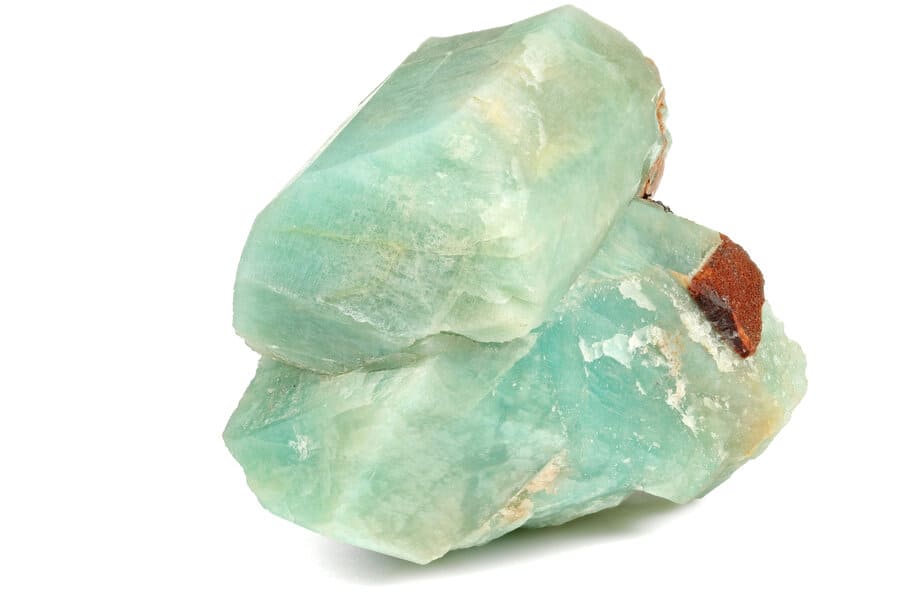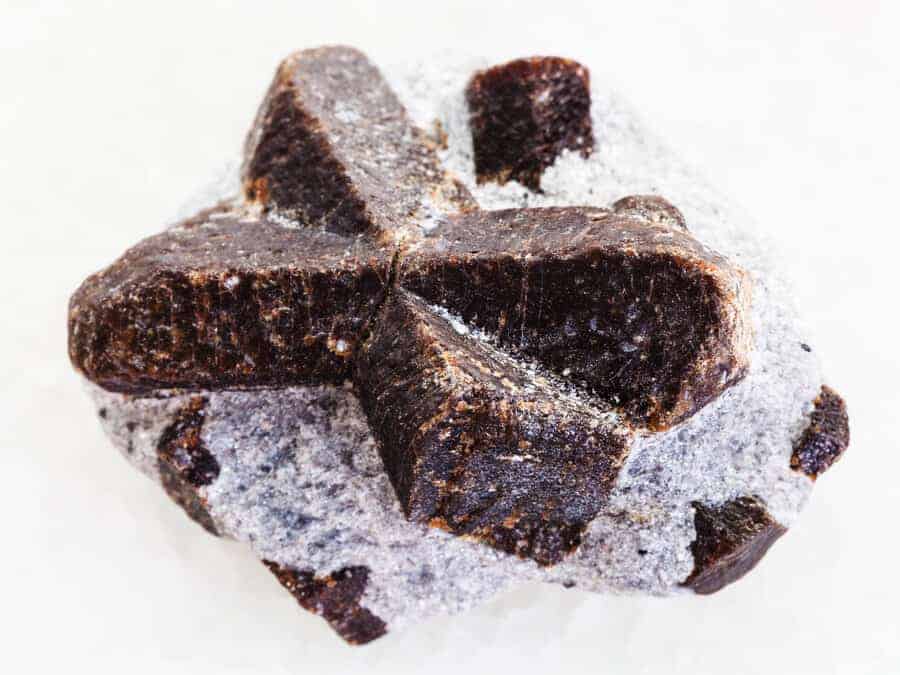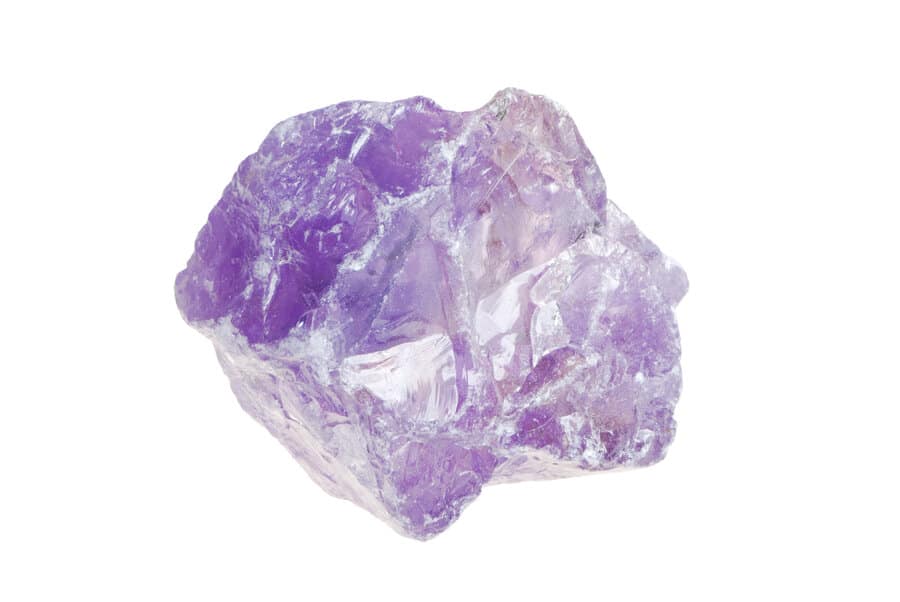If you’re in Viginia and looking to do some rockhounding, you will be delighted to learn that it is a fantastic state for rock and mineral collecting. The varied topography and complicated geology of the state makes for a wide variety of interesting rocks and minerals to be collected and no shortage of places to find them.
Virginia owes most of its rockhounding prowess to the Appalachian Mountains. The mineral rich pegmatites and metamorphic rock found in the central and western parts of the state have long been popular with collectors for their high-quality specimens of minerals like epidote, unakite, amethyst, and amazonite.
Eastern Virginia is primarily made up of younger, sedimentary rocks and is more known for its fossil collecting than its rocks and minerals. Still, there is no shortage of locations to search for collectible rocks like petrified wood and kyanite.
In general, there are far too many old mines and prospects scattered across the state for me to list in their entirety in this article, but there are more than enough locations listed here to point you in the right direction and keep you busy for quite some time.
The best places to rockhound in Virginia are old mines and the gravels of rivers and streams near heavily mineralized areas in the central and western parts of the state, particularly near the towns of Laurel Fork and Stuart. Kyanite mines near Willis Mountain are also very popular rockhounding destinations.
| State Symbols | |
|---|---|
| State Mineral | — |
| State Rock | Nelsonite |
| State Gemstone | Amazonite (unofficial) |
| State Fossil | Chesapecten jeffersonius |

This article will dive deeper into the many great rockhounding sites across the state (along with maps), but I’d like to highlight a few standouts here. The top 10 rockhounding sites for rocks and minerals in Virginia:
- Laurel Fork – Large quartz crystals
- Amelia Court House – Amazonite, Amethyst, Quartz
- Hurricane Knob – Kyanite
- Stuart – Garnet, Kyanite, Staurolite
- Ashland Mill – Moonstone, Kyanite, Amazonite
- Tye River Gap – Epidote, Unakite, Beryl, Quartz
- Henry County – Blue, gem-quality quartz crystals
- Rose River – Epidote, Quartz crystals, Unakite
- Willis Mountain – Kyanite, Topaz, Garnet
- Sayler’s Creek – Amethyst, Quartz crystals
Rocks and Minerals Found in Virginia
Rockhounds in Virginia will be delighted by the huge variety of rocks and minerals they can find here. Virginia is probably most well known for its amethyst and unakite which can be found in relative abundance, particularly in the central part of the state.
What types of rocks and minerals you can find while out searching will obviously depend entirely on the general area you’re searching in. Luckily, almost no matter where you are in Virginia you can hope to find quite a few different rock and mineral varieties while looking for specimens to add to your collection.
The most commonly found and collected rocks and minerals in Virginia are:
- Amethyst
- Quartz
- Staurolite
- Agate
- Epidote
- Unakite
- Amazonite
- Kyanite
- Beryl
- Apatite

If you’ve already found a rock and you’re not sure what it is, I would highly recommend checking out my Practical Rock Identification System. This bundle of information includes a book, videos, and online tools. It is, simply put, the most comprehensive and easy-to-understand rock identification system you’ll find anywhere.
You can also read through my free rock identification guide and mineral identification guide which are filled with useful information and tools.
Rockhounding Sites in Virginia
Through quite a bit of research and cross-referencing of available literature, I have compiled this list of some prospective locations in Virginia which I would recommend to people looking to do some rockhounding. These are mostly comprised of beaches, old mining prospects, washes, streams, and historically known rock and mineral collecting sites. For additional reading, I’d highly recommend these books you can find on Amazon:
Please remember that rock collecting locations are constantly changing. Specimens may become depleted from other collectors, the location may have been built on or altered, locality information in literature may be inaccurate, and property ownership may have changed hands. Joining up with a local rockhounding club for a group trip can often get you access to otherwise off-limits locations like privately owned mines and quarries. There are many rockhounding clubs in Virginia so you can most likely find one you like nearby.
In the tables and maps below, I have listed many mines and prospects where interesting rocks and minerals have been produced from. Please keep in mind that most of them are likely privately owned, meaning you’ll need to get permission to collect on that location. In general, you can use these locations as a guide to point you towards general areas which may contain collectible material
Though there are many locations listed here, this list is far from exhaustive. A location’s listing here is not a guarantee of accuracy. Be safe, never go underground, and make sure to get permission from the landowner to search for and collect specimens.
If you’re planning on heading to the field, make sure you have all the gear you’ll need! To get started, you can check out my recommended gear page which contains my full reviews for every Geologist’s favorite rock hammer and the best hiking backpack I’ve ever owned.
Important Disclaimer: I have not been to these locations myself, and I do not know if they are currently open for collecting. Use this resource as a guide to get you started. Follow posted signage and always get permission from the landowner to collect.
Western Virginia Rockhounding Sites
Western Virginia is probably the best part of the state to go rockhounding. This area is dominated by the heavily mineralized Appalachian mountains and is cut by many pegmatites that have left the area filled with interesting rock and mineral specimens.
There is a long history of mining in western Virginia, and there are far too many old mines and prospects dotting the landscape than are possible to list here in their entirety. Most of these mines were targeting pegmatites and metamorphic rock containing minerals like apatite, pyrite, quartz, epidote, and kyanite.
There are a few areas of western Virginia that rockhounds will be especially drawn to. There is a wide belt centered on the town of Stuart where staurolites (‘fairy stones’) can be found in relative abundance. Similarly, a large area around Laurel Fork is famous for its unusually large and high-quality quartz crystal clusters.
| Location | Rocks & Minerals |
|---|---|
| Walker Mountain, area on N slopes | Quartz crystals, Agate |
| Pipers Gap, W side of highway | Hornblende, Serpentine, Talc |
| Galax, area 3 mi. N in mining dumps | Apatite (gem-quality, green), Chalcopyrite, Pyrite, Rutile crystals, Selenite, Calcite, Siderite, Vivianite (dark blue, bladed) |
| Hillsville, area mining dumps (Betty Baker Mine) | Arsenopyrite, Azurite, Barite, Chalcocite, Chalcopyrite, Chrysocolla, Cuprite, Galena, Pyrite, Pyrrhotite, Siderite, Sphalerite, etc. |
| Laurel Fork, area farms and gravels | Quartz crystals (some large) |
| Blue Ridge, general area in Floyd County | Staurolites |
| Floyd, area outcrops and gravels 2 mi. NW | Quartz crystals (rutilated) |
| Chestnut Creek Wetlands, in soils of general area | Quartz crystals (some large) |
| Chestnut Mountain, general area on SE side | Garnet, Biotite, Quartz crystals, Tourmaline |
| Glade Hill, area just S | Apatite crystals (yellow) |
| Spruce Run, in gravels W of Giles | Quartz crystals |
| Hanks Knob, general area in gravels, streams, etc. | Garnet, Pyrite, Pyrrhotite, Quartz crystals, Rutile |
| Elk Creek, area 1.5 mi. E | Chalcedony |
| Galax, area exposures 6.5 mi. SW | Garnet (spessartine) |
| Mink Ridge, in area exposures | Soapstone |
| Troutdale, area outcrops and road cuts in area 2.5 mi. SE | Epidote, Jasper (red), Unakite |
| Bonys Run, area prospects | Smithsonite |
| Hurricane Knob, general area | Kyanite (gem-quality) |
| Stuart, area stream gravels, road cuts, etc. | Garnet (almandine), Staurolite, Corundum, Kyanite |
| Airpoint, in a road cut | Unakite, Apatite, Rutile |
| Salem, in exposure behind Dixie Caverns | Agate (smoky) |
| Marion, surrounding area esp. to SW | Barite, Calcite, Iron minerals, Limonite, Malachite, Pyrite |
| Whitetop, in rhyolite outcrop to Mt. Rogers | Calcite, Fluorite, Selenite, Siderite |
| Wythe County, regional lead and zinc mines | Aragonite, Calcite, Fluorite, Bornite, Marcasite, Smithsonite, Sphalerite, Dolomite, Pyrite, Cerussite, etc. |
Central Virginia Rockhounding Sites
Rockhounding in central Virginia is highlighted by the amethyst that can be found in gravels and fields all throughout the area. Like the rest of the state, there are countless mines and prospects which have historically produced high-quality specimens of minerals like epidote, fluorite, quartz, and rhodonite.
Central Virginia is also known for unusually high-quality unakite, which is a metamorphosed version of granite sporting a distinct and attractive shade of green. This green color is caused by a high epidote content, and it makes the rock a very popular item with collectors looking to create cabochons from the material.
Eastern Virginia Rockhounding Sites
Eastern Virginia, while not as heavily mineralized as the rest of the state, is still a great place to do some rockhounding. River and stream gravels all over this part of the state are loaded with collectible material like petrified wood, unakite, kyanite, and amethyst.
Virginia’s Atlantic beaches are generally a great place to do some beachcombing for agates and other quartz-family minerals. They are also among the only places where you can find ‘Clam Geodes’, which are fossilized clam shells lined with beautiful crystals.
Most of the best rockhounding sites in eastern Virginia are in the northeastern part of the state where the topography is a little more interesting and the geology lends itself to the creation of interesting rocks and minerals. This area has many quarries and old mines which are historically known for producing minerals like epidote, prehnite, and quartz. You’ll also probably want to search the stream and river gravels of northeastern Virginia for beautifully blue quartz crystals, which are sometimes even chatoyant.
Where to Find Geodes in Virginia
Geodes are some of the most popular rocks sought by rockhounds all over the world, and Virginia is no exception. Unfortunately, Virginia isn’t known for having great geode hunting locations. In fact, I could find only a few sites where geodes have been reportedly been found.
Tip: Not sure if the rock you’ve found is a geode? Check out my article about how to identify a geode.
You may feel a little discouraged to hear that, but while the locations where you can find geodes are limited, the geodes that are found there are highly unique.
The best places to find geodes in Virginia are the area just south of Virginia Wesleyan University and in the sands and gravels of Virginia Beach, especially at low tide. These geodes are actually fossilized clam shells lined with dogtooth calcite, which are fairly unique to the area.
If you want to try your hand at finding more traditional geodes I would recommend extending your search radius and trying some sites in a neighboring state, particularly Kentucky, Tennessee, and North Carolina.
Where to Find Crystals and Gemstones in Virginia

There is nothing quite like uncovering a quartz crystal with a perfect termination or finding a beautiful agate that has been waiting in a river bank for you to come along and take it home. Gemstones are some of the most enjoyable specimens that rockhounds can find, but it’s not always easy to know where to look.
Tip: Check out my Complete Rock Tumbling Guide to make your rocks and gemstones really shine!
Virginia is prime territory for finding crystals and gemstones thanks to the many highly mineralized regions which are now being eroded by countless streams and rivers. The pegmatites and metamorphosed rocks which are exposed on the surface play host to many varieties of collectible gemstones and crystals.
The best places to find crystals and gemstones in Virginia are:
- Laurel Fork – Large quartz crystals
- Amelia Court House – Amazonite, Amethyst, Quartz
- Hurricane Knob – Kyanite
- Minnieville – Amethyst, Quartz crystals
- Henry County – Blue, gem-quality quartz crystals
- Charlotte Courthouse – Amethyst, Quartz crystals
- Stuart – Garnet, Kyanite, Staurolite
- Rose River – Epidote, Quartz crystals, Unakite
- Trevilians – Amethyst, Quartz crystals
- Front Royal – Quartz crystals, Unakite
Virginia Rockhounding Laws & Regulations
One of the most common questions rockhounds have is whether or not they are allowed to collect at a certain location. It is the responsibility of each rockhound to obtain permission from a landowner to search and/or collect on a piece of property.
The ownership and status of land can and does change frequently, making it impossible to document accurate information for every location on this page. However, I have compiled a list of resources here so that you may investigate and obtain permission for any locations (found here or elsewhere) for yourself.
Public Land Resources
I have written entire articles which cover the rockhounding laws and regulations for nearly every type of public land you can think of. I encourage you to check them out if you are curious about the legalities of rock and mineral collecting.
- Rockhounding on Public Land: Laws and Regulations
- Can You Collect Rocks in State Parks? All 50 States Answered
To determine what type of public land a particular location is on, I would recommend starting with the Virginia Department of Conservation & Recreation’s maps.
Private Land Resources
As with most states, each county in Virginia will have records of who owns each piece of property. You can also usually get the landowner’s name and address by visiting the county records office. I would probably start by contacting the assessor in whatever county you’re interested in and getting whatever contact information you can for the landowner.
Sources & Further Reading
For information on fossil hunting in Virginia, I’d highly recommend checking out my full guide on Virginia fossil collecting.
The locations and information contained in this article are primarily derived from academic papers, online resources, and other outside sources. If you would like to read some of the source material for yourself I have listed them below. The majority of these locations are my interpretation of Robert Beste’s A Location Guide for Rock Hounds in the United States. Other sources include:
